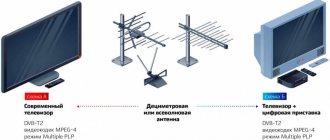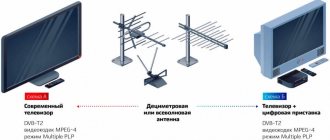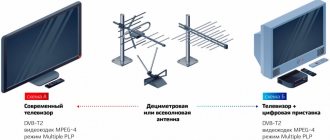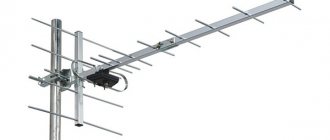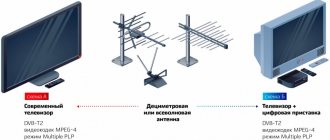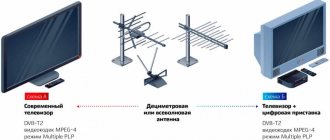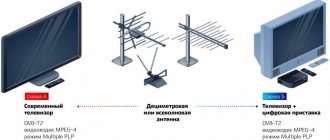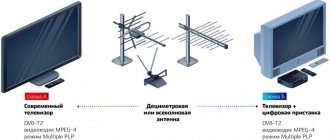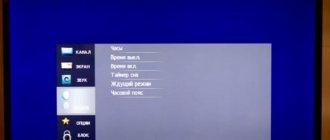What is needed to switch to digital TV in Vologda
If you have a TV made before 2013 or an older model, you will need to buy a set-top box for it. Its cost starts at 600 rubles. The receiver must understand the MPEG4 standard.
An external or indoor antenna is required for the receiver to operate. The TV tuner can be connected to a public antenna. If there is no such antenna, you will need to contact the Housing Office.
To watch digital television, you will have to watch a TV purchased in 2013 or later. Such devices are capable of working with the DVB-T2 standard, which guarantees the reception and decoding of digital broadcasting in the Russian Federation. In this case, to switch to digital broadcasting in Vologda, you just need to configure it by simply rummaging through its menu.
In most multi-storey buildings in Vologda, the signal arrives through a district repeater. After processing through the tuner, it is distributed via cable to residential buildings. In such a situation, residents will not need to use auxiliary devices.
The Vologda region will be one of the last to abandon analog TV
In December, Russia will complete the creation of a terrestrial digital terrestrial television broadcasting network. The Vologda region will be one of the last to abandon analogue TV and switch to digital. What should owners of old TVs do when this happens?
What are we talking about?
Before 2010, almost half of Russian residents (44%) could receive no more than four TV channels. At the same time, the possibilities for the development of analogue broadcasting had already been exhausted. Thanks to the introduction of digital technologies, by the end of this year, 98.4% of the country’s residents will be able to watch ten TV channels of the first multiplex for free, and more than 98% of TV viewers will be able to watch 20 channels of the first and second multiplexes.
In the Vologda region, the process of switching on the broadcast of the second multiplex was completed on December 20.
Multiplex is a package of digital television channels broadcast by one transmitter. It usually occupies one frequency. In digital terrestrial television, the multiplex includes 10 TV channels.
The first includes Channel One, “Russia 1”, “Russia 2”, “Match TV”, NTV, Channel Five, “Russia - Culture”, “Russia 24”, “Carousel”, OTR, TVC; in the second - REN TV, Spas, STS, Domashny, TV-3, Friday, Zvezda, Mir, TNT, Muz-TV.
Digital television broadcasting makes it possible to improve the quality of image and sound, save frequency resources, and also provides the opportunity to develop new modern services. There is no charge for the opportunity to watch digital television of the Russian Television and Radio Broadcasting Network (RTRS), since the TV channels are broadcast without coding and in the public domain.
The final transition to digital format in the country will be gradual. It will begin in February 2021 and will last six months. In our region, analogue broadcasting of mandatory public television and radio channels will cease on June 3 next year. As reported on the official website of RTRS, after the shutdown, a message will be posted on their frequencies about the need to switch to digital television reception. This screensaver will be displayed for a week.
How it works
Terrestrial television distributes the signal using terrestrial repeater stations. As mentioned above, there are analogue and digital broadcasting. How to understand that you have analog TV that will be turned off?
In his interview with Rossiyskaya Gazeta, RTRS General Director Andrei Romanchenko explained that if there is a letter “A” on your TV screen next to the channel logo, it means you are receiving analogue television and you should set the TV to receive “digital”. The letter “A” appears on the logos of eight TV channels: Channel One, Rossiya 1, NTV, TNT, Channel Five, REN TV, STS and Zvezda.
The easiest way to set up the new format is on modern TVs. They already have everything necessary to receive and recognize a digital signal. To do this, you just need to connect the antenna, start an automatic channel search, and then the TV will tune itself.
It will be more difficult with old technology. You will need a special attachment for it. It costs from 700 - 800 rubles and is sold in electronics stores, as well as in post offices. How to connect it can be seen in the diagrams presented.
Moreover, if there are several TVs, then in order to watch different programs in different rooms, each device will need a separate set-top box. Of course, many Russians already have flat-screen TVs, but even among them there are some that are not suitable for receiving digital broadcasts. And this, as noted in RTRS, needs to be paid attention to. That is, make sure that the receiver supports the DVB-T2 standard. Information about this should be indicated on it.
In order for such a TV to catch a digital signal of the DVB-T2 standard, you need a decimeter antenna. It can be either home or communal. So far, there are very few houses where there are such common antennas, and therefore the regions are recommended to take measures to restore systems for collective reception of terrestrial television in apartment buildings, but in digital format. The bulk of the remaining antennas on the roofs of houses are analogue. It is recommended to gradually change them to decimeter ones.
Alternative
Many Cherepovets now have satellite or cable television. Is it worth giving them up? This is a personal matter for everyone. All three options have their pros and cons.
As Rechi was told in one of the electronics stores, the main advantage of satellite TV is that it allows you to watch thousands of TV channels, regardless of location. That is, the dish allows you to receive a signal well even far from large populated areas. The disadvantages of satellite TV include the relative high cost and difficulty of installing and configuring the equipment yourself.
As for cable television, its advantages include better image and sound quality compared to an analog signal, increased noise immunity, a large number of channels and the ability to use additional services.
The disadvantages are dependence on the operator, inaccessibility to rural areas, installation price and the presence of a subscription fee.
What about the locals?
RTRS reports that regional TV channels and TV channels that are not part of multiplexes will continue analogue broadcasting in the new year.
As Oleg Smirnov, technical director of Channel 12, explained to Rechi, for now the channel’s viewers should not be afraid of any surprises. He will continue to broadcast the same way as before, and what will happen next, time will tell.
According to him, it was assumed that there would be a third multiplex where regional channels could enter, but for now this all remains at the level of talk. The Ministry of Telecom and Mass Communications of the Russian Federation recommended that local television switch to other broadcasting platforms, primarily cable television. A law was even passed on the 21st button for 72 channels, which were exempt from cable distribution fees. According to it, in each subject, in accordance with the procedure established by the government, one mandatory public channel is selected, to which the 21st position on the television remote control will be assigned. In the Vologda region, “Russian North” became such a channel.
In addition, it is reported that regional programs of the State Television and Radio Broadcasting Company "Vologda" are currently available on the channels of the first multiplex "Russia 1", "Russia 24" and "Radio Russia" for 97.81% of residents of the Vologda region. The volume of regional digital broadcasting for Rossiya 1 is 102 minutes on weekdays, 104 minutes on Saturdays and 40 minutes on Sundays. For Rossiya 24 - 60 minutes on weekdays, for Radio Russia - 150 minutes on weekdays.
RTRS reminds that the program does not provide for a “collective” forced transfer of households to receive digital terrestrial television and warns about possible scammers who may offer this. We would like to add that questions related to the transition to digital television can be asked by calling the RTRS hotline: 8-800-220-20-02. The call is free throughout Russia.
Ilya Dranitsin
What channels are available in Vologda
There are 3 multiplexes in Vologda. The first two of them are standard and broadcast federal news and entertainment channels. The remaining multiplex is operating in testing mode. It shows channels about sports, science, and wildlife.
On August 1 last year, the Ostankino television tower began transmitting a signal in the DVB-T2 standard. The channel broadcasts 7.5 hours of special information in UltraHD format. All subscribers of Vologda and the Vologda region have the opportunity to receive the image.
The transition to digital television in the Vologda region will provide a rare opportunity to get rid of the old analog television. Digital TV provides high-quality images and sound.
Digital TV broadcasting
Home>Authority>Executive power>Committee of Information Technologies and Telecommunications of the Vologda Region>Digital terrestrial television>Digital television broadcasting
Construction of a digital terrestrial television broadcasting network (DTTV) in the Vologda region
By Decree of the President of the Russian Federation of June 24, 2009 No. 715 “On all-Russian compulsory public television channels and radio channels,” the creation of digital terrestrial networks to ensure the broadcast of all-Russian public television channels and radio channels is entrusted to RTRS.
On the territory of the Vologda region, the construction of an on-air digital television network is carried out by the RTRS branch “Vologda Regional Radio and Television Transmission Center” (Vologda ORTPC).
The federal target program “Development of television and radio broadcasting in the Russian Federation for 2009-2015” sets the start of construction of digital terrestrial television in the Vologda region for 2012-2013.
To implement the Federal Target Program, on January 17, 2011, an Agreement on Cooperation in the field of development of television and radio broadcasting in the Vologda Region was signed between the Government of the Vologda Region and RTRS.
By order of the Governor of the Vologda Region No. 1126-r dated May 31, 2011, an interdepartmental working group was created to quickly resolve organizational issues regarding the construction of a digital broadcasting network in the Vologda Region.
The construction of a digital television broadcasting network in the Vologda region is carried out on the basis of the system project “Digital terrestrial broadcasting network in the Vologda region” developed by OJSC Scientific and Technical Center “Cosmos”. The project, taking into account the decision of the Government Commission for the Development of Television and Radio Broadcasting dated September 22, 2011, provides for broadcasting in the DVB-T2 standard with MPEG-4 digital compression. In the region, digital transmitters will be installed at 27 existing facilities of the Vologda ORTPC and 9 newly built transmitting stations.
To build a digital television network in the Vologda region, a single-frequency network scheme was adopted. A single-frequency network provides broadcasting over a significantly larger area than a single transmitter. Consolidation of service areas on one radio channel leads to simplified frequency planning and, ultimately, to a more rational use of the frequency resource.
List of objects of the regional network of CETV of the Vologda region
| № | Transmitter installation location | District of Vologda region | TV channel number of the first multiplex (channel frequency, MHz) | Start date of test broadcast of the first multiplex | TV channel number of the second multiplex (channel frequency, MHz) | Start date of test broadcast of the second multiplex |
| 1 | Andoma | Vytegorsky | 38 (610) | 30.09.2013 | 46 (674) | |
| 2 | Borisovo-Sudskoe | Babaevsky | 30 (546) | 27.06.2014 | 35 (586) | |
| 3 | Verkhovazhye | Verkhovazhsky | 25 (506) | 22.05.2013 | 41 (634) | |
| 4 | Vozhega | Vozhegodsky | 43 (650) | 30.05.2013 | 36 (594) | |
| 5 | Vologda | Vologda | 34 (578) | 25.12.2012 | 35 (586) | 07.03.2014 |
| 6 | Vokhtoga | Gryazovetsky | 34 (578) | 17.12.2014 | 35 (586) | |
| 7 | Vytegra | Vytegorsky | 38 (610) | 15.08.2013 | 46 (674) | |
| 8 | Gryazovets | Gryazovetsky | 34 (578) | 17.12.2014 | 35 (586) | |
| 9 | Village | Vozhegodsky | 43 (650) | 10.07.2013 | 36 (594) | |
| 10 | Ida | Babushkinsky | 25 (506) | 12.12.2013 | 41 (634) | |
| 11 | Kirillov | Kirillovsky | 32 (562) | 14.11.2014 | 33 (570) | |
| 12 | Kurilovo | Kichmengsko-Gorodetsky | 39 (618) | 16.04.2013 | 27 (522) | |
| 13 | Lipin Bor | Vashkinsky | 32 (562) | 17.06.2013 | 33 (570) | |
| 14 | Nikolsk | Nikolsky | 39 (618) | 04.06.2013 | 27 (522) | |
| 15 | Nyuksenitsa | Nyuksensky | 26 (514) | 28.06.2013 | 31 (554) | |
| 16 | Ozerki | Vytegorsky | 38 (610) | 15.08.2013 | 46 (674) | |
| 17 | October | Vytegorsky | 38 (610) | 14.10.2013 | 46 (674) | |
| 18 | Omogaevo | Vologda | 38 (610) | 18.11.2014 | 46 (674) | |
| 19 | Oshta | Vytegorsky | 38 (610) | 15.08.2013 | 46 (674) | |
| 20 | Pakhomovo | Kichmengsko-Gorodetsky | 39 (618) | 25.11.2014 | 27 (522) | |
| 21 | Pochinok | Vologda | 34 (578) | 18.11.2014 | 35 (586) | |
| 22 | Pyazhelka | Babaevsky | 30 (546) | 27.06.2014 | 35 (586) | |
| 23 | Roslyatino | Babushkinsky | 39 (618) | 26.11.2014 | 27 (522) | |
| 24 | Sludno | Babaevsky | 34 (578) | 25.04.2013 | 43 (650) | |
| 25 | Syamzha | Syamzhensky | 43 (650) | 23.05.2013 | 36 (594) | |
| 26 | Tarnoga | Tarnogsky | 25 (506) | 28.06.2013 | 41 (634) | |
| 27 | Totma | Totemsky | 25 (506) | 17.04.2013 | 41 (634) | |
| 28 | Turovets | Mezhdurechensky | 25 (506) | 14.11.2014 | 41 (633) | |
| 29 | Estuary | Ust-Kubinsky | 34 (578) | 09.12.2014 | 35 (586) | |
| 30 | Ustyuzhna | Ustyuzhensky | 34 (578) | 06.08.2013 | 43 (650) | |
| 31 | Kharovsk | Kharovsky | 43 (650) | 07.06.2013 | 36 (594) | |
| 32 | Chagoda | Chagodoschensky | 34 (578) | 06.08.2013 | 43 (650) | |
| 33 | Cherepovets | Cherepovetsky | 38 (610) | 25.12.2012 | 46 (674) | 18.03.2014 |
| 34 | Chushevitsy | Verkhovazhsky | 25 (506) | 11.07.2013 | 41 (634) | |
| 35 | Shuyskoye | Mezhdurechensky | 34 (578) | 19.04.2013 | 35 (586) | |
| 36 | Yakutino | Veliky Ustyug | 26 (514) | 27.12.2012 | 31 (554) |
CETV transmitting stations under construction are highlighted in bold.
